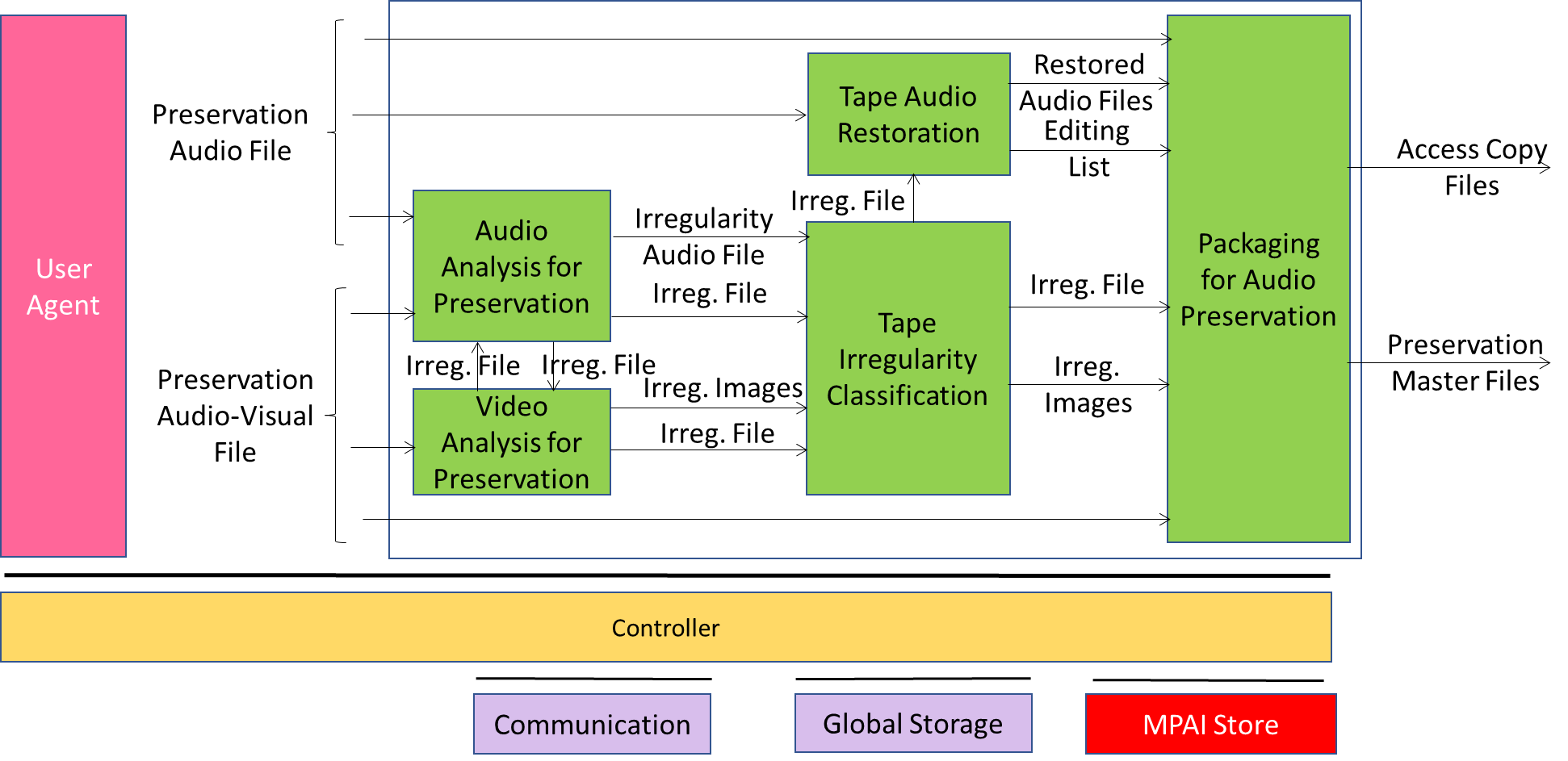1 Version
V2.1
2 Functions
Audio Recording Preservation
- Receives Preservation Audio and the Audio of the Preservation Audio-Visual File obtained by digitising the analogue tape audio recording composed of music, soundscape or speech read from a magnetic tape.
- Produces Access Copy Files and Preservation Master Files produced by a camera pointed to the playback head of the magnetic tape recorder. .
3 Reference Model

Figure 1 – Audio Recording Preservation (CAE-ARP) AIW
The sequence of operations of the Audio Recording Preservation unfolds as follows:
- The analogue audio signal from the open-reel tape recorder is digitised as Preservation Audio File.
- Preservation Audio-Visual File is the combination of:
- The video camera pointed at the playback head of the open-reel tape recorder.
- The analogue audio signal digitised with the same video clock.
- 3. Audio Analysis for Preservation:
- Detects Irregularities.
- Assigns IDs to them that are unique to the analysed open-reel tape.
- Receives an Irregularity File from the Video Analysis for Recording
- Extracts the Audio Files corresponding to each Irregularity received or detected.
- Sends the Audio Files and the Irregularity File related to all Irregularities to the Tape Irregularity Classification.
- 4. Video Analysis for Preservation:
- Detects Irregularities.
- Assigns IDs to them that are unique to the analysed open-reel tape.
- Receives an Irregularity File from the Audio Analysis for Recording and the offset between Preservation Audio File and the Preservation Audio-Visual File.
- Extracts the Irregularity Images corresponding to each Irregularity received or detected.
- Sends the Irregularity Images and the Irregularity File related to all Irregularities to the Tape Irregularity Classification.
- 5. Tape Irregularity Classification:
- Receives an Irregularity File with the corresponding Images and Audio Files.
- Classifies and selects the ones considered relevant.
- If the Irregularity was detected by the Video Analysis for Recording, the selected Irregularity File and the corresponding Irregularity Images are sent to the Packaging for Audio Recording.
- The Tape Audio Restoration uses the Irregularity File to identify and restore portions of the Preservation Audio File.
- The Packaging for Audio Preservation collects the Preservation Audio File, Restored Audio Files, the Editing List, the Irregularity File and corresponding Irregularity Images if detected by the Video Analyser, and the Preservation Audio-Visual File and then it produces the Preservation Master Files and Access Copy Files.
4 Input/Output Data
| Input | Comments |
| Preservation Audio File | File obtained by digitising the analogue tape audio recording composed of music, soundscape or speech read from a magnetic tape. |
| Preservation Audio-Visual File | A Preservation Audio-Visual File produced by a camera pointed to the playback head of the magnetic tape recorder. |
| Output data | Comments |
| Preservation Master Files | Set of files providing the information stored in an audio tape recording without any restoration. As soon as the original analogue recordings is no more accessible, it becomes the new item for long-term preservation. |
| Access Copy Files | Set of Audio Files derived from the Preservation Audio File, where potential speed, equalisation or reading backwards errors that occurred in the digitisation process have been corrected. |
5 SubAIMs
| AIMs | Name | JSON |
| CAE-AAP | Audio Analysis for Preservation | X |
| CAE-VAP | Video Analysis for Preservation | X |
| CAE-TIC | Tape Irregularity Classification | X |
| CAE-TAR | Tape Audio Restoration | X |
| CAE-PAP | Packaging for Audio Preservation | X |
6 JSON Metadata
https://schemas.mpai.community/CAE/V2.1/AIMs/AudioRecordingPreservation.json

